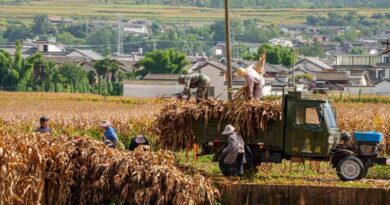India Goes Global: A Prominent Force in Agriculture
Author: Nimish Gangrade, Editor, Global Agriculture
19 October 2023, New Delhi: India’s agricultural sector is witnessing a remarkable transformation, propelling the nation into global prominence. With a rich agricultural heritage and a focus on sustainable practices, India has emerged as a key player in various agricultural exports. From agrochemicals to tractors, basmati rice to spices, Indian agricultural products are making their mark on the international stage. Combined with the government’s commitment to improving farmer incomes and the growing adoption of sustainable farming practices, India’s agricultural landscape is poised for significant change in the coming years.
Agrochemicals: Expanding Global Footprint
India’s agrochemical industry has experienced rapid growth in recent years, bolstering the country’s position as a global exporter. According to the latest data released by the WTO, India has emerged as the second-largest exporter of agrochemicals in the world in 2022 with exports valued at $5.5 billion surpassing the USA with exports at $5.4 billion. China leads the exports in agrochemicals with exports valued at $11.1 billion. This growth can be attributed to factors such as technological advancements, quality assurance, and competitive pricing. Indian companies are actively exploring international markets, establishing partnerships, and expanding their product portfolios to meet the diverse needs of farmers worldwide. With a strong focus on research and development, India’s agrochemical sector is poised to make significant strides in the global arena.
Top 5 Countries in Agrochemical Exports (Source: WTO)

Tractors and Implements: Driving Agricultural Mechanization
India’s prowess in manufacturing tractors and agricultural implements has also contributed to its global agricultural footprint. The country has emerged as a leading exporter of tractors, with a significant presence in both developed and developing countries. In 2022-23, India exported a total of 1,31,850 tractors, displaying its manufacturing capabilities and cost competitiveness. This growth can be attributed to continuous innovation, technological advancements, and the ability to cater to varying farm sizes and requirements. The major destination for export of tractors is USA (25.2%), Nepal (7.3%), Bangladesh (6.5%), Thailand (5.4%) & Sri Lanka (5.3%). The export of agricultural implements, such as harvesters and planters, has also witnessed substantial growth, aiding in the mechanization of farming practices globally.

Basmati Rice: A Fragrant Global Delicacy
India’s aromatic basmati rice has captured the palates of discerning consumers worldwide. Renowned for its fragrance, length, and exquisite taste, basmati rice holds a significant share of India’s agricultural exports. In the fiscal year 2022-2023, India exported approximately 4.5 million metric tons of basmati rice, generating revenue of $4.79 billion. The country’s strict quality control measures, geographical indication protection, and adherence to international food safety standards have contributed to its success in the global basmati rice market. India’s basmati rice is savored across continents, establishing its position as a premium agricultural product.
Spices: Adding Flavors to Global Cuisines
The diverse and aromatic spices of India have been an integral part of its cultural heritage and culinary traditions. India is the world’s largest producer, consumer, and exporter of spices, catering to the global demand for a wide range of flavors. In 2022-23, India exported about 3.1 million tonnes of spices with a value of approximately $4 billion,with countries like the United States, China, and the United Arab Emirates being major importers. The country’s vast spice-growing regions, sustainable farming practices, and stringent quality control measures have propelled India to the forefront of the global spices market. Indian spices continue to enrich cuisines worldwide, bringing a touch of authenticity and flavor to diverse culinary experiences.
Contribution to GDP: The Backbone of the Indian Economy
The agricultural sector has long been the backbone of India’s economy, providing livelihoods to millions of farmers and contributing significantly to the country’s Gross Domestic Product (GDP). As of 2022-23, agriculture accounted for nearly 18% of India’s GDP, directly supporting over 50% of the country’s workforce. The government’s focus on rural development, infrastructure enhancement, and market linkages has further strengthened the sector’s contribution to the national economy. Recognizing the importance of agriculture, the Indian government has implemented various schemes and initiatives to improve farmer incomes and ensure sustainable growth in the sector.
Prime Minister Modi’s Vision: Empowering Farmers
Under the leadership of Prime Minister Narendra Modi, India has witnessed a renewed focus on agricultural development and farmer welfare. The government with a budget of $15 billion (INR 1.24 lakh crore) for the financial year 2023-24 has launched several schemes and programs aimed at increasing farmer incomes, improving agricultural practices, and enhancing rural infrastructure. Initiatives such as the Pradhan Mantri Kisan Samman Nidhi (PM-KISAN), soil health card scheme, and e-NAM (National Agricultural Market) have provided direct financial assistance, soil health information, and market access to farmers. These measures aim to empower farmers, reduce income disparities, and create a more sustainable and inclusive agricultural ecosystem.
Transition to Sustainable Agriculture
India’s agricultural sector is in the midst of a significant transition towards sustainable practices. Farmers across the country are embracing sustainable agriculture techniques to ensure long-term productivity, environmental conservation, and resilience to climate change. Precision farming, which utilizes modern technologies like remote sensing, drones, and data analytics, is gaining traction, enabling farmers to optimize resource utilization and enhance crop efficiency. Additionally, the adoption of organic farming, conservation agriculture, and agroforestry practices is on the rise, promoting soil health, biodiversity, and reducing chemical inputs.
The Future: A Drastic Change on the Horizon
India’s agriculture sector is at the cusp of transformative change. With the government’s commitment to farmer welfare, technological advancements, and the growing adoption of sustainable practices, the future of Indian agriculture looks promising. Over the next 2-3 years, we can expect a significant shift towards more efficient and environmentally friendly farming practices. The increased focus on precision farming, organic agriculture, and conservation techniques will lead to improved productivity, resource optimization, and reduced environmental impact.
India’s agricultural sector has emerged as a global force, with its agrochemicals, tractors, basmati rice, and spices making their mark in international markets. The significant contribution of agriculture to India’s GDP highlights its importance in the country’s economic fabric. With the government’s unwavering commitment to farmer welfare and sustainable practices, the sector is poised for further growth and transformation. The transition to sustainable agriculture and the adoption of precision farming techniques will not only benefit farmers but also contribute to global food security and environmental sustainability. As India goes global in agriculture, it paves the way for a brighter and more sustainable future for its farmers, consumers, and the planet as a whole.
Also Read: International Tractors Limited (ITL) launched 5 new tractor series under the brand Solis
(For Latest Agriculture News & Updates, follow Krishak Jagat on Google News)















